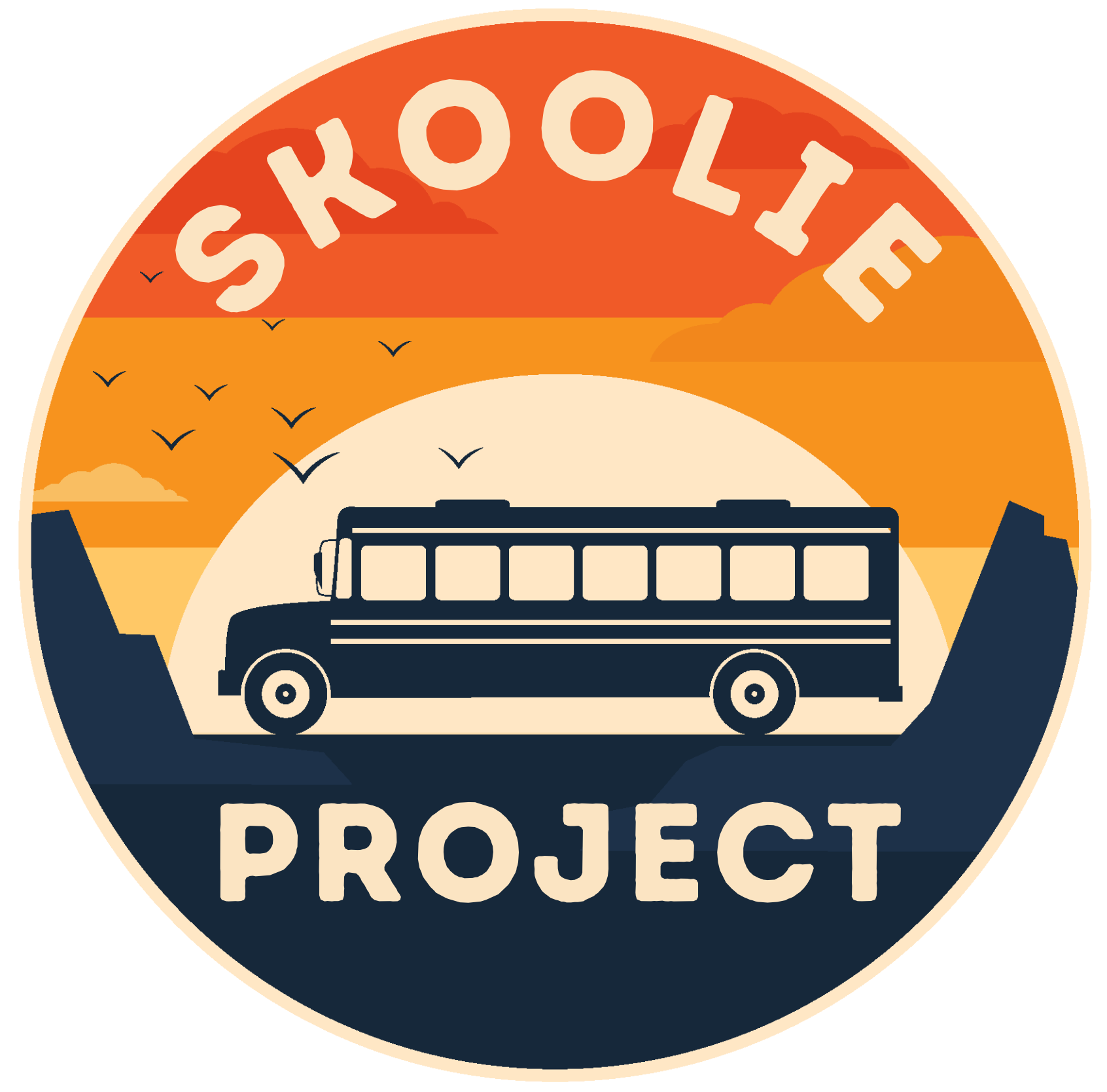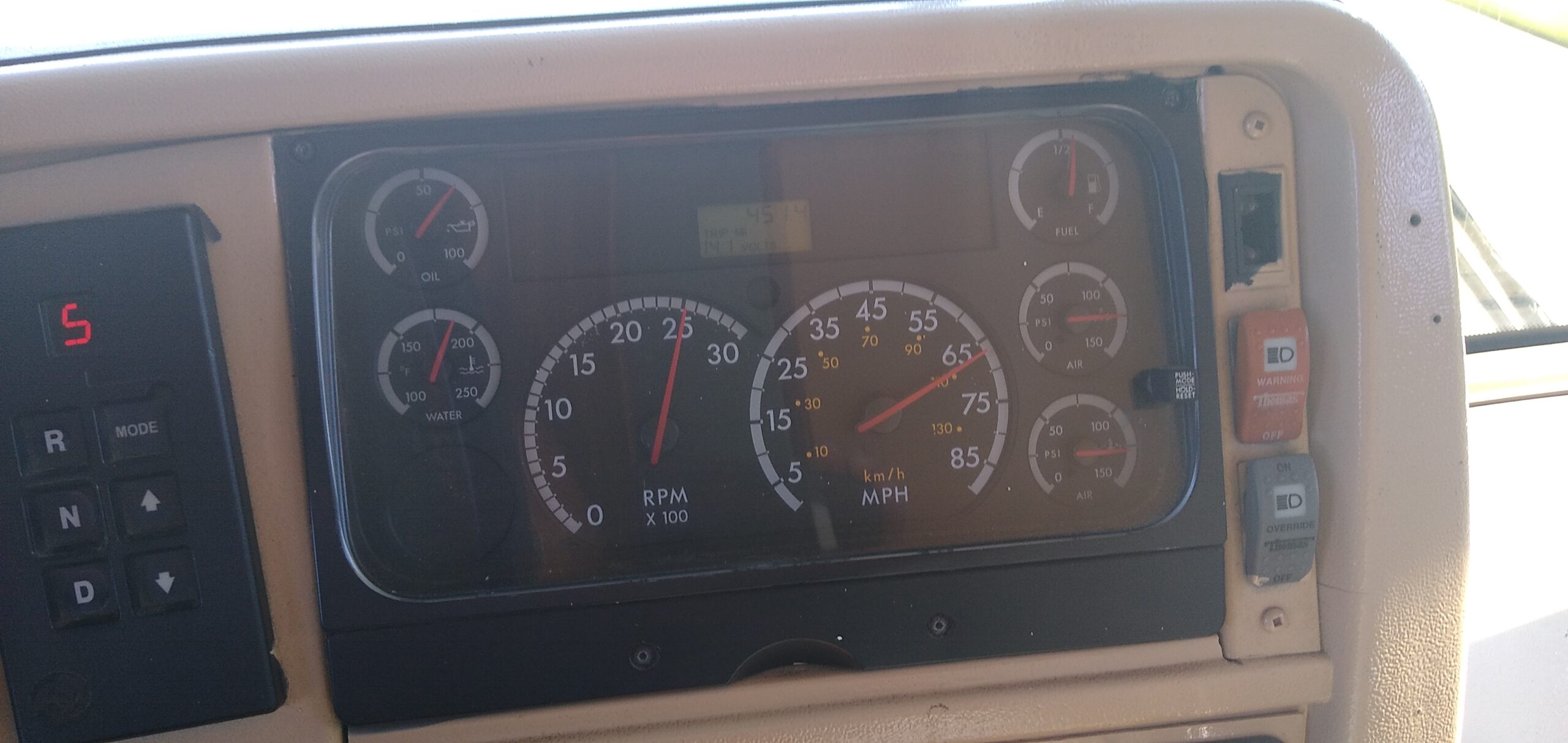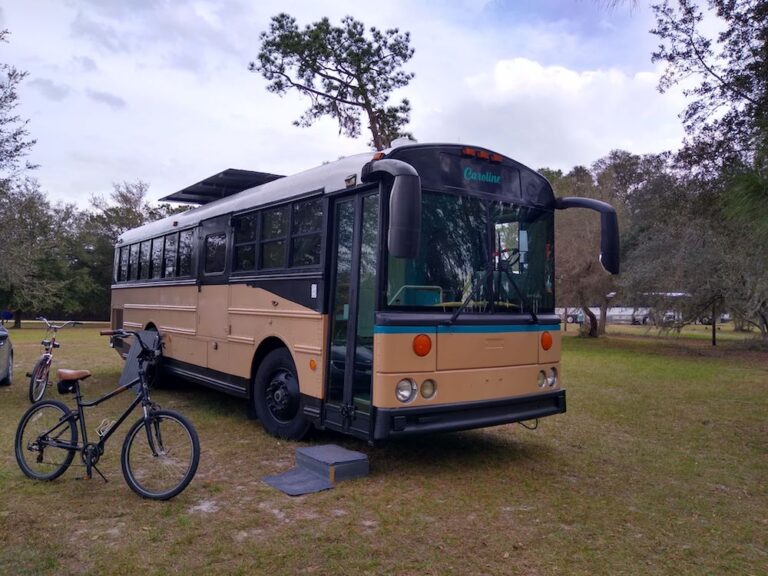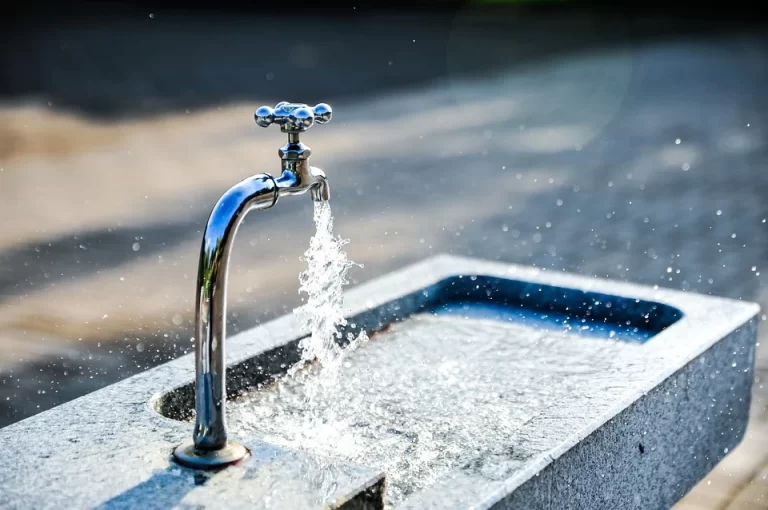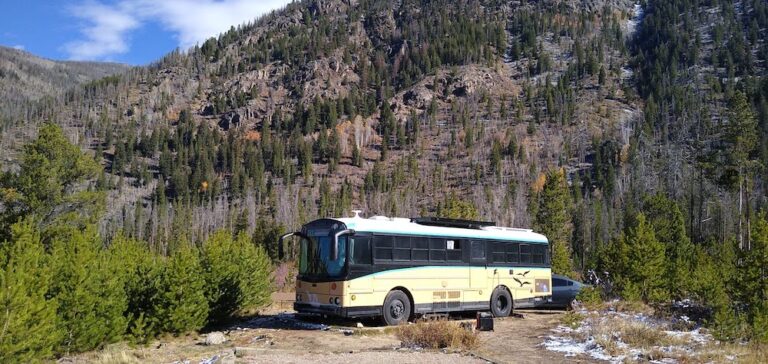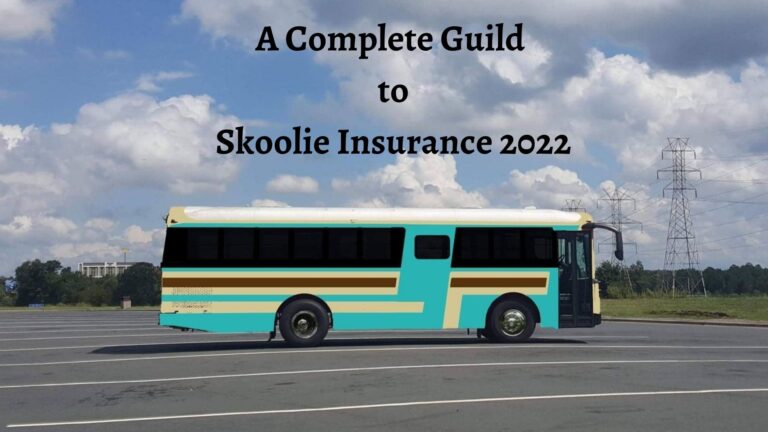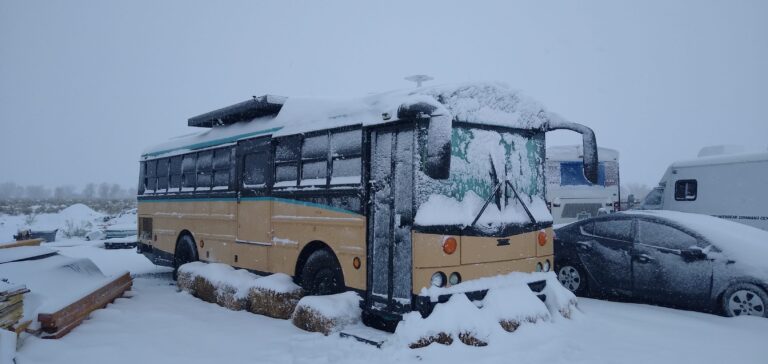What Is The Average Fuel Economy Of A Skoolie in 2023?
Determining the average fuel economy of a skoolie can be a tricky and deceiving formula.
When we found our perfect skoolie back in 2018, we were so excited. I mean, elated! We knew we had a winner with the MBE906 engine (Mercedes-Detroit) coupled with the Allison MD3060.
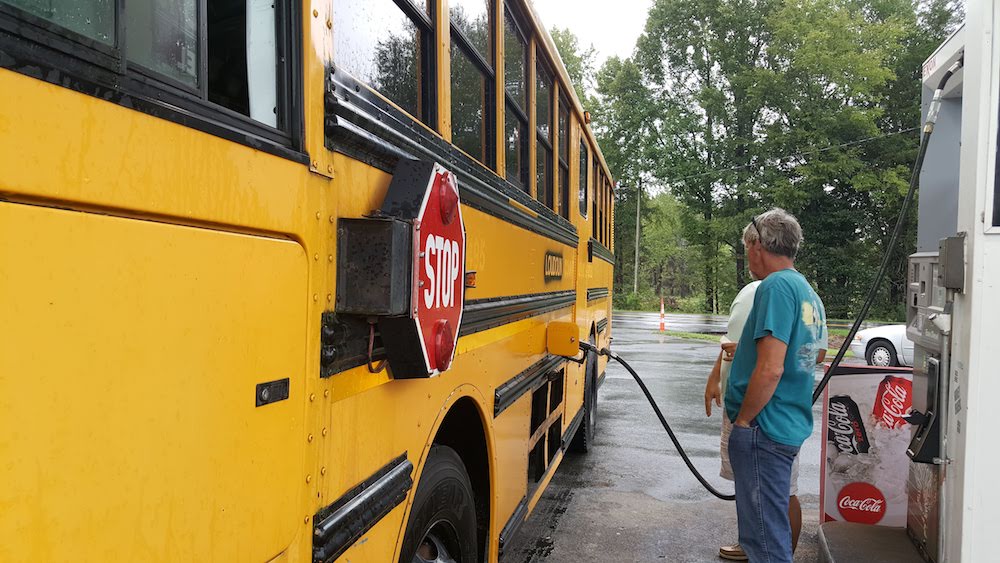
We had read that this bus got somewhere in the range of 10 to 12 mpg. Considering the size of the bus and it would carry all of our belongings across the United States, we were quite content with those numbers.
It performed exactly as we had read. Between Virginia and Central Florida, we got right at 10 to 11 mpg. With a 100-gallon fuel tank, we were ecstatic with the idea of 1000 miles to a tank of gas.
Back then, the price of a gallon of diesel was between $2.85 and $3.00 a gallon, so it was not so bad to go 1000 miles on $300 of fuel. Now, depending on where in the country you are, fuel is going to run you $4 – $5 per gallon on the interstate.
So we thought.
Fast forward to a little over a year and we are making our maiden voyage. Let’s just say our bus, Caroline, was a tad bit heavier than when we drove her home from Virginia. By the way, we had already removed all of the seats, floors, ceiling, and walls in North Carolina at my cousins’ farm.
Caroline went from 10 to 11 mpg down to about 6 to 8 miles per gallon. That was a big difference. While we were driving her, we could almost see the fuel gauge moving ever so slowly from full towards empty. The fuel economy of a skoolie has a direct correlation to how heavy it is.
It was a realization that weight matters when it comes to skoolie builds! We figured at least we were running diesel and not gasoline!
Does A Skoolie Use Gas or Diesel?
A skoolie, or skoolies, use both gas and diesel. Well, let us clarify that statement. A single skoolie does not use both, but skoolies, in general, can use gas or diesel, just not both. Therefore, the fuel economy of a skoolie will depend on whether you are running gasoline or diesel.
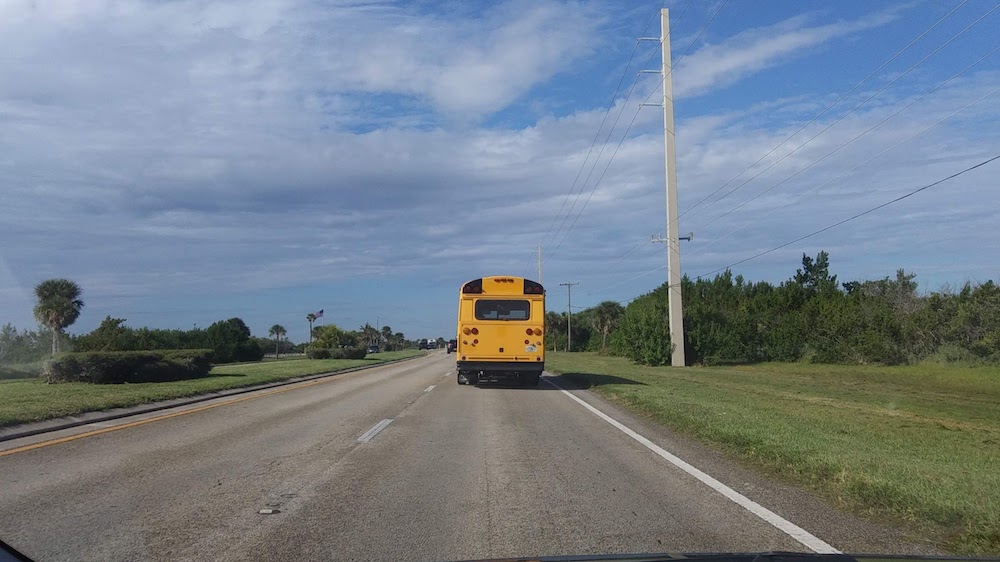
Many of the older model skoolies from the 1970s use gasoline engines. Most modern skoolies from the 1990s and forward are diesel-powered engines.
Of course, there are “shorty” skoolies who still run on a gasoline engine as well.
See where we are going with this?
Our point here is that some skoolies run on gas and some run on diesel. You will know if your bus runs on gas or diesel just by the sound of the engine and the smell of the exhaust alone. It is a very distinct sound and smell.
Some say, myself included, it is music to your ears and perfume for your nose. Breathing in diesel exhaust is not recommended, however! It may smell good to some people, but it is rather unhealthy for everyone.
We prefer the diesel engine ourselves. Particularly, the Mercedes engine. Driving Caroline was a dream with that engine! Not a lick of trouble for the little over two years we owned and drove her.
We liked and trusted the Mercedes engine so much, we purchased a Mercedes Sprinter for our second DIY and our third DIY is a Thomas bus as well with, you guessed it, an MBE906 engine.
We are convinced diesel is the way to go when traveling full time!
Why Is Diesel Better Than Gas?
There are a lot of people who would stand their ground and argue until the cows come home over whether diesel or gas engines are better. Our stand on this is whatever works best for you.
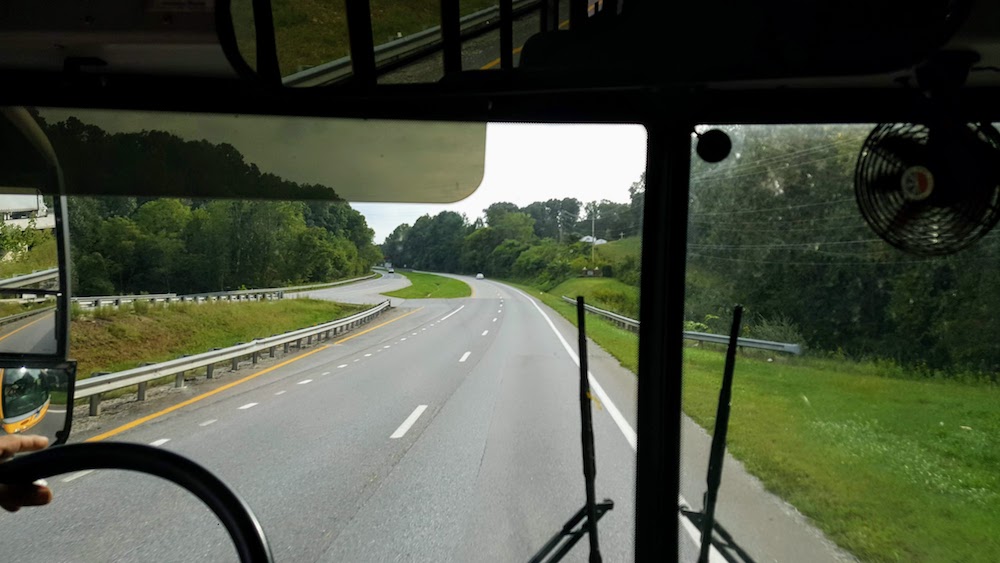
For us though, we are team diesel all the way! The average fuel economy of a skoolie with a diesel engine is far superior to a gasoline-powered skoolie.
There is some sound reasoning for our choice of diesel over gasoline engines. Here are our top 5 reasons why we prefer diesel over a gas engine.
- You Get Better Fuel Mileage From A Diesel Engine
Because they are 10% to 15% more efficient than gasoline engines, they will yield 20% to 30% better fuel mileage.
This could potentially equate to significant financial savings when considering long-distant trips. - Diesel Engines Are More Efficient
A diesel engine provides 10% to 15% more kinetic energy than gasoline engines which make them more efficient - You Will Go Further On A Full Tank Of Fuel
The result and product of better fuel efficiency and fuel mileage, you will go further on a tank of fuel than you would on a tank of gasoline.
- Diesel Engines Last Longer
Because of the efficiency of energy used by a diesel engine, it will last 3 to four times longer than a gasoline-powered engine. The fuel economy of a skoolie is going to yield better results with diesel. - They Just Sound Sexy
Have you ever listened to the purr of a diesel engine? Yes, we know that there are some damn sexy gasoline engine growls.
Shelby or Cobra Mustang, an 8 cylinder Camaro SS, Dodge Challenger SRT Demon, Corvette C7R, or the Lamborghini Murcielago.
The big diesel engine sounds strong and powerful, but tame and gentle at the same time.
When it is all said and done, the diesel engine is simply superior to a gasoline engine when it comes to traveling in a skoolie.
If your skoolie has a gasoline engine, I am sure you will agree with us as you are filling up your gas tank.
How Much Fuel Does A Skoolie Use?
If you are anything like us, before you start a trip you plan out how far the trip is in miles. How long it will take to reach your final destination and how much fuel do you estimate you will use. We are not meticulous planners mind you.
Depending on the size of your fuel tank, you can estimate fairly accurately how far you can travel between fuel-ups. That is, of course, assuming you have been keeping track of your fuel efficiency.
We keep a logbook and document every time we fill our diesel tank. We document the date, mileage, mileage traveled since the last fill up and the amount of diesel to fill our tank.
By this data, we can determine what our running mile per gallon, better known as MPG, is and determine if we are losing or maintaining fuel efficiency.
How Much Does It Cost To Fill A Skoolie Fuel Tank?
The amount of money it costs to fill your skoolie depends largely on the amount of fuel your fuel tank will hold.
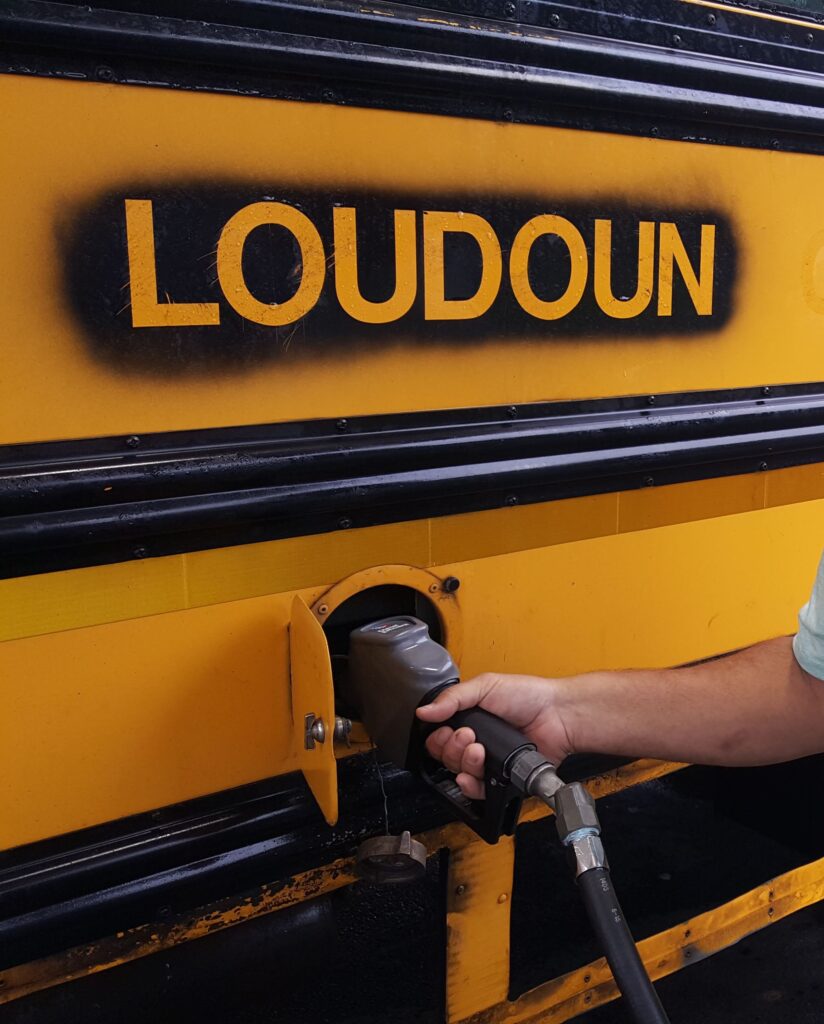
Most diesel pushers hold 100 to 150 gallons of fuel. So, just by doing simple math, you can determine the cost of a full fuel tank assuming it was on empty.
So, if you have a 100-gallon fuel tank and the price of diesel fuel is $3.80, then it is going to cost you $380 to fill your tank from empty.
Fuel Rewards
There are ways to save on your fuel costs while traveling. One of the ways we save on fuel costs is by taking advantage of fuel rewards with different brands.
BPme
By joining the BP fuel rewards program you can expect to save 5¢ for every gallon” purchased. As long as you spend at least $100 per month, you will continue to save at the 5¢ level. Otherwise, you drop to 3¢ per gallon savings.
Shell Rewards
With the Shell savings program, you have two levels of saving at the pump.
Gold Status will give you a 5¢ savings per gallon.
Silver Status will give you a 3¢ savings per gallon
Exxon Mobile Rewards+
Exxon’s Mobile Rewards+ offers customers up to 7¢ discount per gallon if they purchase 100+ gallons of diesel or gasoline within a calendar month. They also offer savings of 4¢ for in-store merchandise.
Pilot/Flying J myRewards
There is always a Pilot or a Flying J along the interstate. Pilot gas stations are known to have diesel mechanics on hand in the event of needed maintenance or repairs.
If you purchase 75 or more gallons of diesel in a calendar month, you can earn up to 5¢ savings on each gallon of gas. You can even earn points towards showers, Wifi, and food.
Gas Buddy
The Gas Buddy app is a downloadable app for Apple or Android phones that will locate gas stations nearby for the lowest-priced gasoline or diesel fuel.
It is a geo-synchronized app for your real-time location. Easy to use and does not cost anything.
A great tool to have for those of us who travel full time and want to maximize our fuel costs budget.
How Many Miles Can A Skoolie Go On A Tank Of Fuel
How many miles you can travel on a single tank of gas depends on a
few different factors. Not all skoolies are created the same and that especially goes for their engines.
As we have already discussed, if you are sporting a diesel engine, you are going to get better engine and fuel efficiency. As a result, you are going to be able to go further on a tank of gas.
Just how far you go will depend on the following factors.
- Fuel Tank Capacity
- Speed Driven
- Weight of Your Skoolie
- How Smooth the Traffic is Flowing
We will talk about the four items above in a little more detail below when we address how to improve your MPG.
What Kind Of Diesel Fuel Does A Skoolie Use?
Newer model school buses use ultra-low sulfur diesel fuel. By using ULSD fuel, the engines and emission systems can reduce the overall carbon footprint.
All vehicles, skoolies included are required by law to only run “On-Road” diesel.
On-Road v. Off-Road Diesel
The difference between on-road and off-road diesel comes down to on-road diesel has an excise tax attached to it and therefore is more expensive.
On-Road is sometimes referred to as “clean diesel” because it is clear and looks more like gasoline.
Off-road diesel however has a red dye to it and is not taxed. It is primarily used for farm or agriculture equipment, and therefore is cheaper.
Penalties For Running Off-Road Diesel In Your Skoolie
The off-road diesel is dyed a reddish color so it makes it easier for DOT officers to identify what type of diesel you are running in your rig.
Other than the red-dyed color, there is no difference between the two diesel fuels. A skoolie will operate just as it would with on-road diesel. It would just be cheaper to fill your tank as well as being illegal.
If you are caught running your skoolie with off-road diesel you will get fined by both state and federal governments.
The fine for operating off-road diesel is either $1,000 or $10 per gallon of off-road diesel, whichever is the greater.
What Is The Most Fuel Efficient Skoolie?
With there being so many different sizes of skoolies with so many different engines and transmission combinations, there has to be a front runner for the most fuel-efficient skoolie.
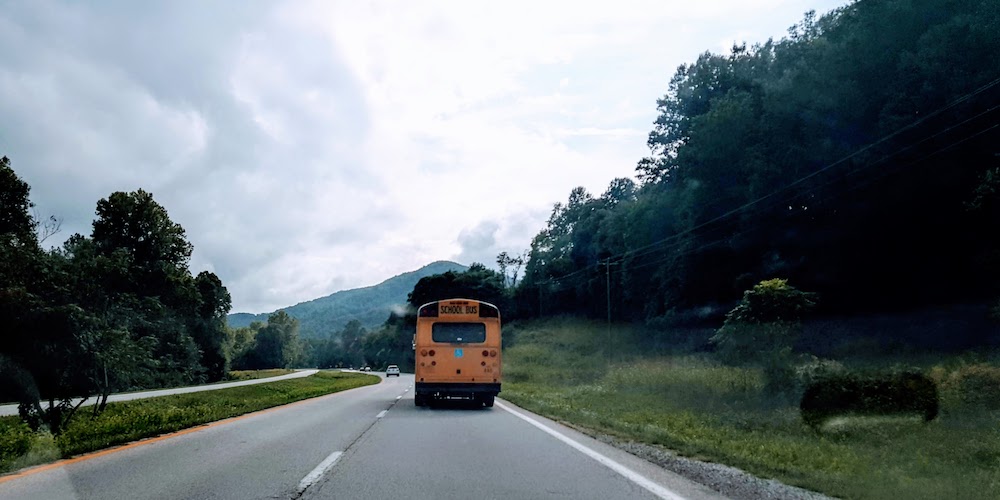
Well, considering that some skoolies have a governor to restrict speeds and some have a 5th or 6th gear locked by the manufacturer, there are too many variables to fairly claim a winner.
Also, consider that some skoolies have their roofs raised and lots of additional “stuff” on their roofs to increase drag and resistance. Never mind if you have decided to pull a trailer or a tow vehicle.
To give a general idea of the average or typical fuel efficiency or MPG, we will look at the typical styles of skoolies and compared them to RVs.
A Diesel Pusher or “full-size” Skoolie 5 to 10 MPG
A Mid-size Skoolie – 7 to 13 MPG’
A Shorty Skoolie – 14 – 18 MPG
These are averages based on a median taken from manufacturers across the different engines and makes of school busses used.
Want to go a little deeper on different skoolie sizes and which size is best for you? Check out this blog post we wrote on, School Bus Sizes For A Skoolie Conversion.
Each skoolie will get different results based on weight, engine maintenance, tires, aerodynamics, road conditions, and topography.
In summary, the most fuel-efficient skoolie is the one that is the lightest and keeps the RPMs under 2000rpms and speed under 60mph.
How Far Can You Drive A Skoolie In A Day?
How far an individual can drive a skoolie in a day depends upon how comfortable and alert they can stay. Some people can drive 8 to 12 hours in one stretch with no problem. Others may only be 3 to four hours max before they are either too uncomfortable or start to doze off.
How far you can drive in one day should never be a competition with yourself or anyone else. It should never be a situation where you are pushing your limits to try to make it to a destination before pulling over for a rest.
With that being said, if there is more than one driver in your skoolie and each of you is familiar and comfortable driving the skoolie, then really, there is no limit to how far or how long you can drive your skoolie in a day.
With multiple drivers switching off every 3 to five hours while the other rests or sleeps allows you to almost run continuously down the road.
When we are driving, we prefer to keep our driving distances to 4 to 6 hours maximum. We can and have driven longer than that, but it becomes more and more uncomfortable.
The next day is usually a day of recovery and rest when we do a full day of driving the day before.
How Can I Improve My Skoolie Fuel Economy?
When your gas tank is guzzling your fuel almost as fast as a thirsty kid drinking Kool-aid on a summer day, finding ways to improve your fuel economy becomes a priority.
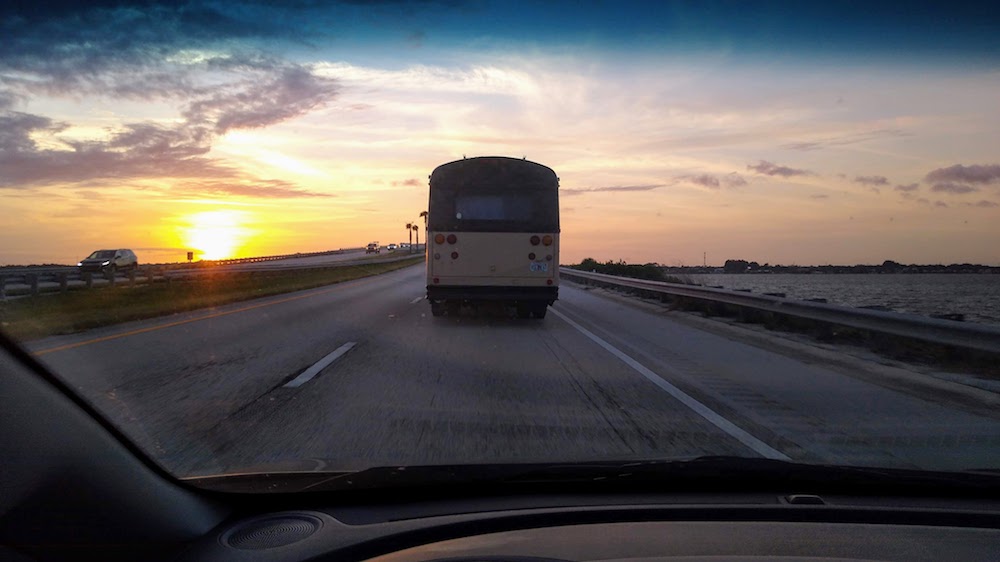
Fortunately, there are several ways of improving your fuel economy regardless of whether you are driving a skoolie with a diesel or gasoline engine.
There may be other ways, but these are the simplest and quickest way to increase your MPG as you are heading to your next adventure.
Drive Slower
Why the big rush? You are already at home in your Tiny Home and time is on your side. Realistically speaking, if you slow your speed down by 5 MPH, you are only losing about 15 minutes to your next destination.
By slowing down that 5 MPH, you would be saving a significant amount of money that could go towards upgrades for your bus.
Besides saving money on fuel, you are also saving wear and tear on your engine and tires. Driving a little bit slower is much safer considering you are probably driving a vehicle with over 20,000 lbs in the first place.
Our “sweet spot” is between 62 and 67 MPH. This keeps our RPMs at around 2000 RPMs and we don’t feel like we are a hazard to other drivers.
We get decent MPG when we stay below 65 MPH. Any slower than that, while we are saving on fuel more, we are also getting passed by every grandma or grandpa out for a Sunday stroll down the road.
Pack Lighter
Our first build was packed with everything we could possibly fit in our bus. I mean we had it all. You couldn’t tell our bus was heavy, but we know it was heavy!
For our current skoolie build, we have decided we are going as light as we possibly can.
No under-belly storage. Avoiding a “big” freshwater tank. No maxing out our storage cabinets inside of the bus either.
We are traveling fast and light. In our defense, we are planning on storing a majority of our personal belongings on some property we are looking to purchase in Arizona.
This way, we can travel as light as possible and still have a “home-base” where we can store family heirlooms and memories. Do we really need to haul around our Nintendo 64 and Sega game system?
Change Air Filter Regularly
This may not seem like a big deal to save on fuel efficiency, but keeping your air filters clean will have a direct impact on your MPG.
Besides the fact that you will see a slight improvement in your fuel milage, your engine will thank you as well as your oil performing a bit more efficiently as well.
Use Cruise Control (If you have it)
If your skoolie is equipped with cruise control, first of all, congratulations and count yourself as fortunate. Secondly, by using your cruise control you can increase your fuel efficiency by as much as 7 to 14%.
Depending on how far your trip is to your next destination or how much you travel in a year overall, it could equate to significant savings.
Pro-Tip
Only use your cruise control on open highway runs when there is little to no traffic for safety. The average fuel economy you will save is worth it!
Avoid Heavy Traffic
When traveling in heavy traffic, you are constantly breaking and accelerating. This is going to have a significant negative impact on your fuel mileage. If you want to increase the average fuel economy of your skoolie, then avoid heavy traffic.
The longer you can drive without accelerating and breaking, the better your MPG is going to be. Heavy traffic will increase braking and accelerating that ultimately reducing your fuel efficiency.
Wrap Up – What Is the Average Fuel Economy Of A Skoolie?
Increasing the average fuel economy of a skoolie is one of or should be the biggest priority while traveling on your bus. The more you can save on fuel the more money you will have to play and go places.
One of the main reasons we all live and travel in a skoolie is for experiences and adventures. Finding ways to save on fuel costs while traveling is fun.
What are some ways you save on the average fuel economy of your skoolie while traveling? We would love to hear from you! Leave us a comment below.
We hope to connect with you soon!
